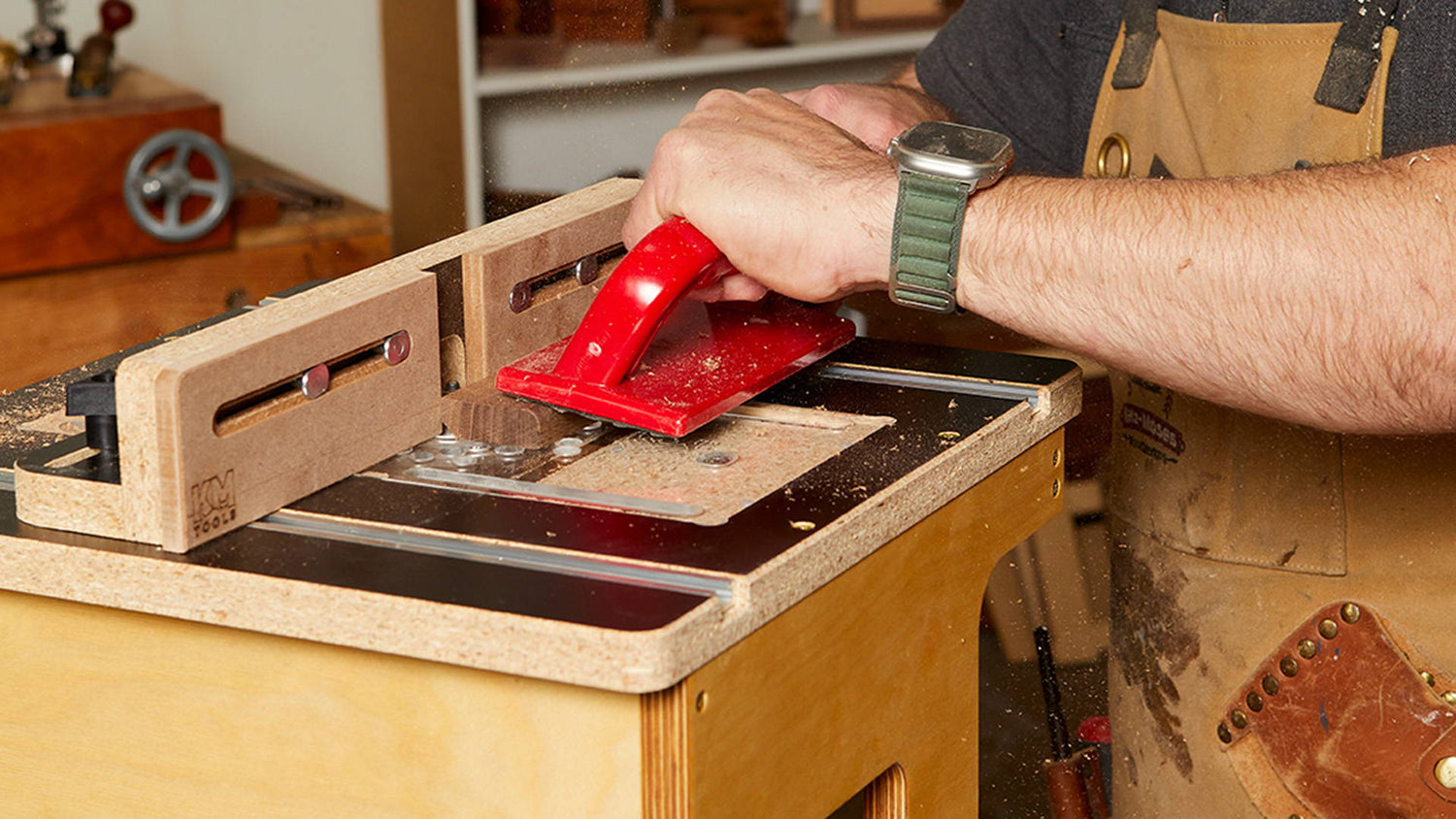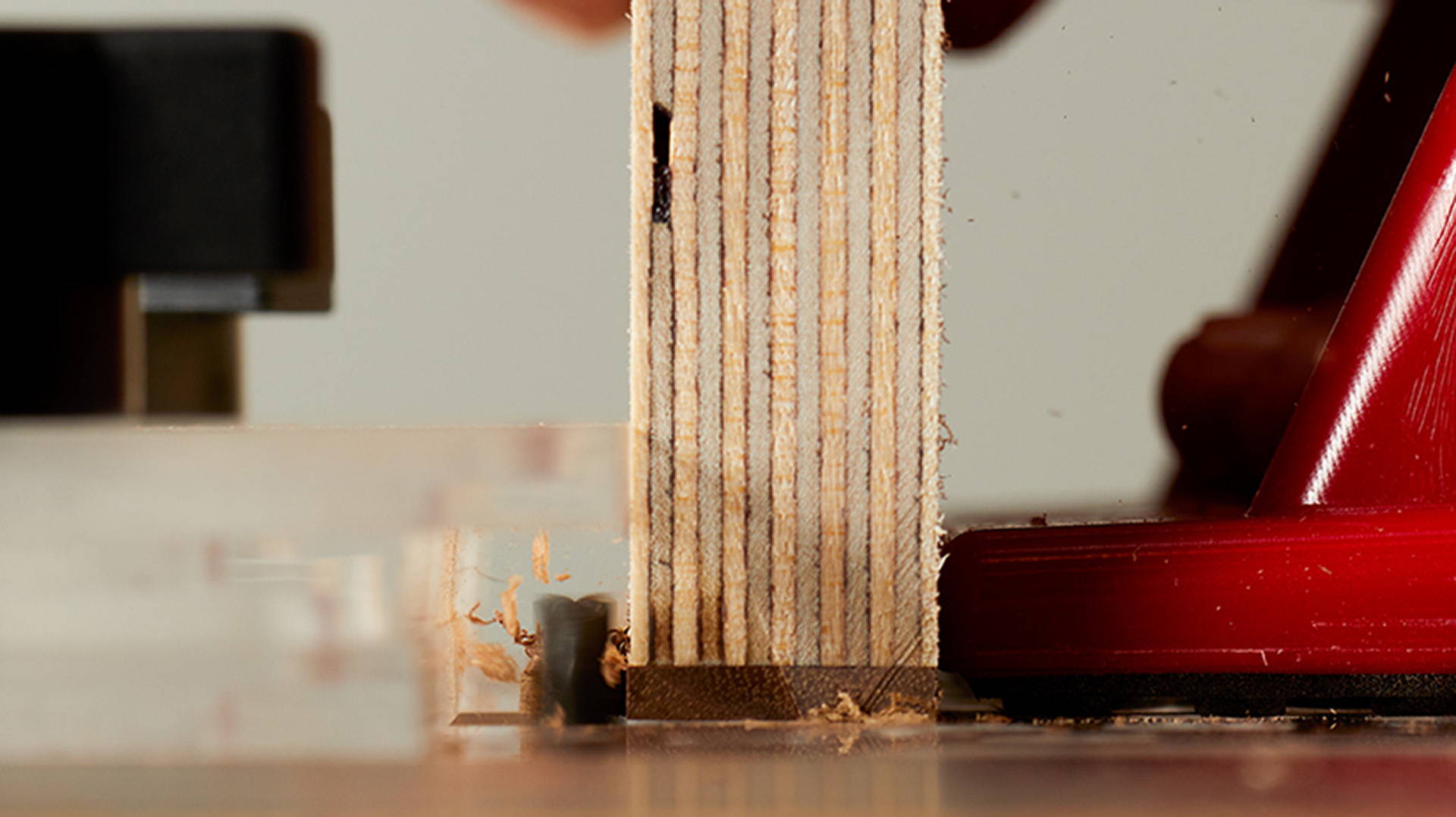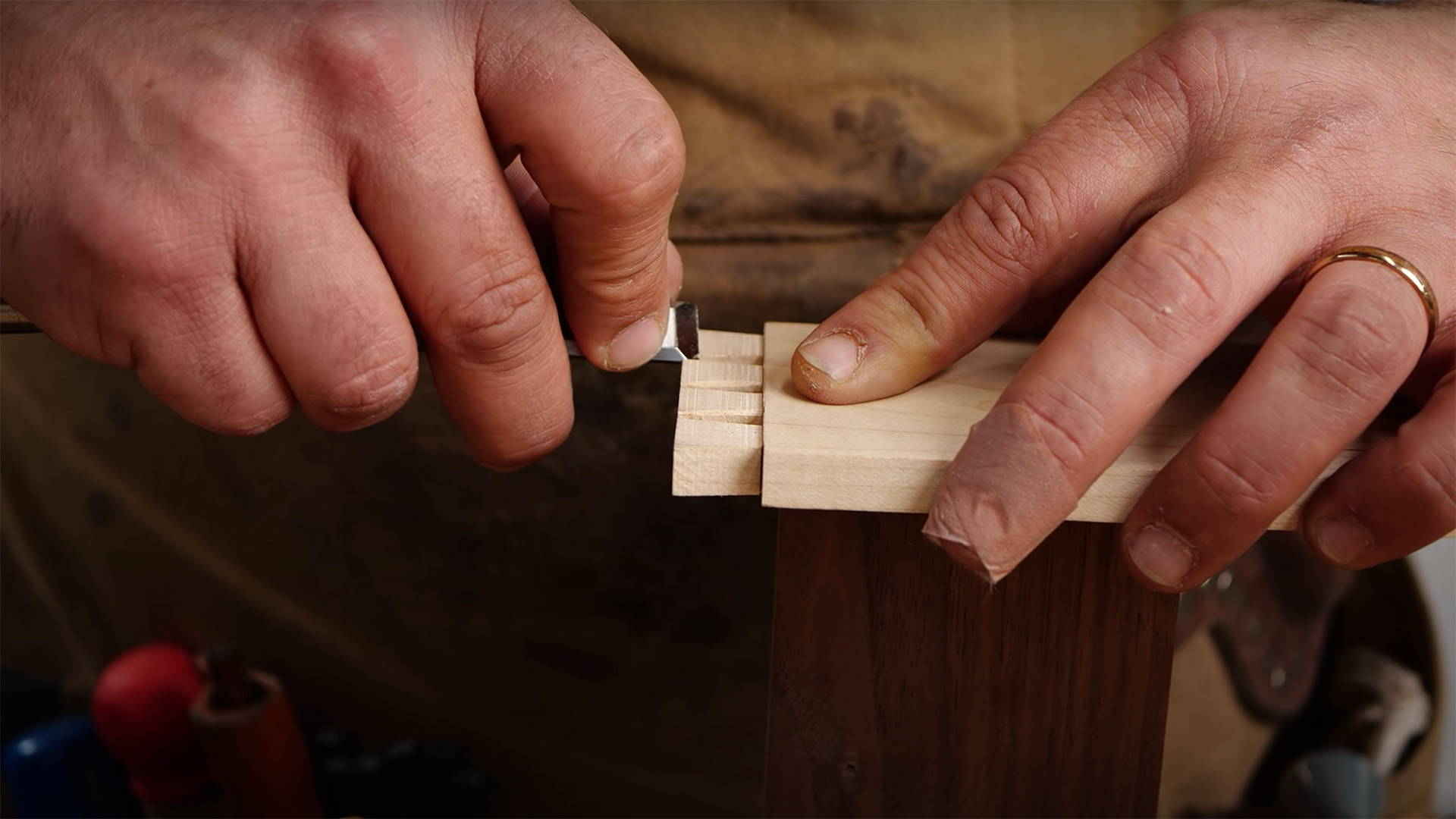If I could only have one power tool in my shop, it would be my table saw. But a very close second would be my router table.
Router tables are useful for so many things. And most importantly, they’re quick and easy to set up.
But new woodworkers might not understand the point of a router table.
Afterall, if you have a handheld router… isn’t that all you need?
Today, I’m giving you a crash course in Router Table Basics so you can understand why they’re so useful and practical.
You’ll learn how router tables can save you a ton of time… and help you get better results along the way.
We also just released our very own Benchtop Router Table designed to fit the 3x3 Custom 6-in-1 Universal Trim Router Jig.
This compact design includes a fence with adjustable faces, storage for ¼” shank router bits, t-track for attaching fixtures or jigs, and the possibility of adding a safety pin.
It’s super simple to attach or remove the 6-in-1 Router Jig base plate, so you can quickly switch between using your trim router handheld or in the table.
Don’t own a 6-in-1 Universal Trim Router Jig? You can even make your own baseplate to fit the router table.
WHAT IS A ROUTER TABLE?
At its core, a router table is just a platform that holds a router upside down with the bit facing up.
The router is attached to the underside of the tabletop, where a hole lets the router bit poke through to the other side.
This lets the user make cuts by sliding the workpiece over the table and through the bit, as opposed to moving a handheld router across a workpiece.
A router table can be as simple as a hole in your workbench with your router base screwed into the bottom.
More sophisticated versions include router lifts, fences, t-track, safety pins, stop/start switches, dust collection, LED-lit jacuzzis, and bit / tool storage.
ROUTER TABLE VS HANDHELD ROUTER
The biggest difference between a router table and a handheld router is whether the router bit is oriented up or down.
And this isn’t arbitrary.
Router bits rotate clockwise, and need to have wood feed through them in a specific direction:
Right to left on router tables and left to right with handheld routers (more on feed direction here).
Router tables also have a lot of built in features that make them more convenient and quicker to set up than handheld routers:
- Greater stability: Moving the workpiece over the flat tabletop means you don’t have to worry about router stability with narrow boards.
- No workholding: Using handheld routers usually requires some kind of workholding to keep the workpiece steady — and this is often inconvenient because clamps get in the way of cuts. With a router table, there’s no need for clamps and cuts are unhindered.
- Built in fence: If you need to cut a groove or rabbet in a board, the router table fence is a lot quicker and more accurate to set up than a handheld router edge guide.
- Jig platform: With a fence and t-track, router tables serve as a perfect platform for all types of jigs. You can cut box joints, bridle joints, and more far more easily on a router table than you could with a handheld router.
Of course, there are times when a handheld router is the way to go — especially if you’re working with massive boards that would be hard to balance on a router table.
ARE ROUTER TABLES DANGEROUS?
Router tables can be dangerous. But it’s easy to stay safe as long as you follow certain guidelines.
Read this to learn all about staying safe while using router tables.
The biggest risk is kickback and the fact that the bit is exposed. You want to make sure to use push paddles and keep your fingers clear of the bit.
Unlike handheld routers, a router table can’t fly out of your hands, so that’s a plus.
But as long as you’re careful and don’t do anything too dumb — you should be fine.
WHAT ARE ROUTER TABLES USED FOR?
Router tables can be used for almost anything a handheld router can — but there are a few situations where they really shine.
TEMPLATE ROUTING
Template routing involves using a flush trim or pattern bit to cut a workpiece to match a template.
It’s the easiest way to get identically shaped parts — especially with non-rectangular shapes.
I do almost all my template routing on a router table.
It lets me see the workpiece to make sure everything’s going to plan, and allows me to quickly move through multiple pieces without having to worry about workholding.
EDGE PROFILING
Edge profiling can be a lot simpler and more accurate with a router table compared to a handheld router.
This is especially true for narrow pieces that might night have enough surface area for the base of a handheld router to be stable.
When cutting chamfers or roundovers on multiple pieces, a router table lets you simply set the height and blast through each workpiece with no set up time.
Just make sure you’re feeding from right to left!
GROOVE CUTTING
The fence on a router table makes cutting grooves, dados, and rabbets a breeze.
There’s no worrying about slipping on an edge guide — and no worries that auxiliary guides you clamped down might be out of square.
The adjustable fence opening on most router tables lets you expose only as much of the bit as you need while keeping the cut safe as possible.
You can even add a stop block to help cut stopped grooves.
JOINERY
One of the most useful things about a router table is that they can be used in lieu of a dado stack.
And with the addition of specialty jigs, you can cut all sorts of joinery on a router table.
These jigs can either ride over the top of the fence (like this box joint jig) or in t-track for a different approach.
Half laps, bridle joints, even dovetails with enough set up — the router table is a great way to cut all these joints.
KM TOOLS BENCHTOP ROUTER TABLE
We just released a flat-packed Benchtop Router Table designed to work with the 3x3 Custom 6-in-1 Universal Trim Router Jig.
With only two bolts (which are conveniently tightened with the jig handles), you can turn your trim router into a fully functional router table.
Some of the features it includes:
- Adjustable fence with adjustable face pieces
- Two rows of t-track for attaching fixtures and jigs
- Storage for ¼” shank router bits
- Black melamine top for a low-friction surface
The design makes it lighting quick to switch between using your router in the table or handheld. And it’s easy to make any modifications or upgrades you can think of!
ROUTERS, START YOUR ENGINES
Router tables can be absolute workhorses in your shop — and are an upgrade every new woodworker should consider.
They let you enjoy all the functionalities of a handheld router with less setup time…
And often, greater and more reliable accuracy.
Want to learn more about router table safety? Here’s 10 Tips for Staying Safe with Router Tables.
What tips do you have for making mitered boxes? Let us know in the comments below!
Follow us on Instagram @katzmosestools, on TikTok @katzmoseswoodworking, and check out my YouTube channel for more great woodworking content...
And as always, STAY SAFE IN THE SHOP!













2 comments
Mark Blute
I recently got one delivered but it seemed to not have any assembly instructions. Can I please have a copy emailed to me.
I recently got one delivered but it seemed to not have any assembly instructions. Can I please have a copy emailed to me.
Frank Kalinski
Really like the Benchtop router table! I bought a larger table from Rockler when I worked for them – router tables truly are leap up in ability to do so much more precise and consistent output.
The only thing I would be concerned with in your table is bit storage where the operator has to change out the router motor
Frank
Really like the Benchtop router table! I bought a larger table from Rockler when I worked for them – router tables truly are leap up in ability to do so much more precise and consistent output.
The only thing I would be concerned with in your table is bit storage where the operator has to change out the router motor
Frank